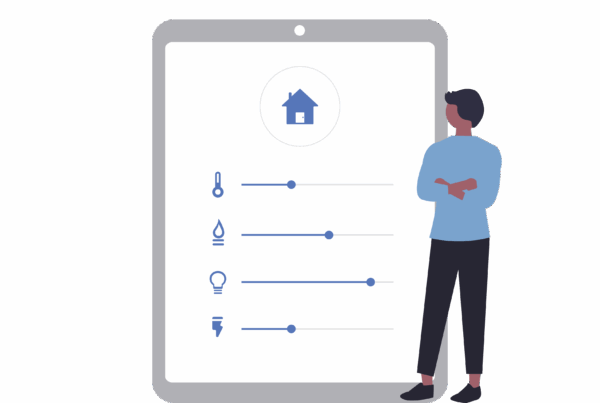
What to Look For in a Smart Device in 2022
With so many smart home gadgets available, how do you choose the right ones? Well, you need to start by thinking about your needs. Are you looking to secure your home? Do you want to conveniently turn off lights or play music with just your voice?
Regardless of what you’re looking for, there will be a smart device that can do it. For home security, check out smart video doorbells, security cameras, and locks. For convenience, browse through smart displays, robot vacuums, speakers, and lights. To save on money, look at smart thermostats, sprinklers, and plugs. Always check out the device’s features before making a purchase.
Most smart devices are capable of more than you might expect. For example, any device with built-in Alexa gives you access to the voice assistant. As such, you’ll then be able to use Alexa as you would with any other Alexa device. So you can use, say, a smart plug to check the weather, read the news, review your shopping list, and perform other Alexa tasks.
Now that you have a general idea of how to shop for smart devices, check out our list of the best devices available.
Best Smart Display: Google Nest Hub (2nd Gen)
Pros
- ✓ Affordable
- ✓ Uses Sensing Technology, Soli, and Quick Gestures
- ✓ Great sounding speakers
- ✓ Comes with built-in voice control
Cons
- ✗ No camera
Looking for an affordable smart display with built-in voice control? Get your hands on Google’s second-generation Nest Hub, a smart display that’s a huge improvement over the original.
The second-generation hub doesn’t have a camera, so you can’t use it to Facetime or Skype with others. But it does have a larger screen and improved sound quality that is great for watching your favourite Netflix shows and YouTube videos. The enhanced speakers are great for listening to your favourite songs on Spotify, as well.
One of the Nest’s most interesting features is Soli, a radar sensor chip that lets you control the smart display using hand gestures. This lets you play around with Quick Gestures to control the Hub using various hand gestures and voice commands. The Nest Hub also uses Sleep Sensing technology which helps monitor your sleep using motion and sound.
With the smart display, it almost feels like a Google Nest and an Echo Show combined. It’s fun, convenient, and keeps you connected to friends and family. For more generic uses, you can use the display as a digital photo frame, or as a display to control your compatible smart devices—it’s versatile!
Pros
- ✓ Crisp and rich sound quality
- ✓ Works with Alexa and Google Assistant
- ✓ Supports AirPlay
- ✓ Customizable performance using Trueplay or Sonos app
Cons
- ✗ Slightly expensive
For high-performance audio combined with great style, opt for the Sonos One. Being on the pricer side, you’re getting a lot for your money, including built-in support for Amazon Alexa and Google Assistant.
You’ll notice right away that the Sonos One delivers exceptionally crisp audio quality. This smart speaker is top of its class when it comes to sound. Using the included two Class-D amplifiers, a tweeter, and a mid-woofer, the speaker can fill any room with immersive sound. It’ll render any note the way it was meant to be heard.
However, if you want to mess around with the One’s performance, you can install the Sonos app to make adjustments. For more customizability, you can also tune your Sonos One with Trueplay. Trueplay is software that allows you to fine-tune your speakers so that you can optimize the sound anywhere.
The speaker has touch controls on the top, so you can easily play, pause, and skip tracks. Of course, you can use voice commands with Alexa or Google Assistant for that as well. Listening to music or immersing yourself in movies has never been better.
In terms of design, the One is incredibly sleek and minimalistic. It’s the perfect addition to your home and can easily become the centerpiece. And since it’s wireless, you can transform any room into your own soundstage.
Best Smart Light Bulb: Philips Hue
Pros
- ✓ Over 16 million colors
- ✓ Works with Alexa, Google Assistant, and Apple HomeKit
- ✓ Bluetooth accessible
Cons
- ✗ Requires hub to link more than 10 lights
- ✗ Expensive
When installing a smart light bulb, you want something that’s easy to set up and has bright white and vivid colours for any setting. That’s why we recommend the Philips Hue, a smart bulb that can fit into any environment.
Although the price tag is expensive for a smart bulb, it’s quite an upgrade from previous Hue bulbs. You used to need a special hub to use them, but now, Philips Hues smart bulbs work on their own. You can still install the hub if you’d like, as it allows you to link up to 50 lights instead of only 10 on the app.
The hub also gives you additional features to control the lights. You can group lights by rooms or zones and sync them when playing movies, games, or music. There’s even a security feature that can randomly turn the lights on and off around your home to make it seem like you’re there. This is handy when you’re away from home to deter people from breaking in. So even though you may not need the hub, it can be pretty useful.
Philips Hue bulbs are Bluetooth accessible, so you can control them from the Philips Hue app. In terms of smart home integration, the bulbs are compatible with Alexa, Google Assistant, and Apple HomeKit. You can control them using voice commands, which is great as you no longer need to flip a switch. It also pairs with Nest and Samsung SmartThings, giving you more options to add lights to your home automation.
Best Smart Switch: Lutron Caseta Smart Start Kit
Pros
- ✓ High-value kit
- ✓ Works with many leading smart home devices
- ✓ Voice control with Alexa, Google Assistant, and Siri
- ✓ Easy and fast installation
Cons
- ✗ Remote not included
- ✗ The bridge must be connected using Ethernet
Connecting your lights can be simple and easy with the Lutron Caseta Smart Start Kit. The kit includes a smart switch, smart bridge, and wallplate. You’ll have everything you need to control your appliances more conveniently.
Lutron’s Start Kit integrates seamlessly with Alexa, Google Assistant, Apple HomeKit, Ring, Serena Shades, and Sonos. You can control your devices using voice commands with Alexa, Google Assistant, and Siri. However, to use Siri, you need to set up the included smart bridge.
On top of using voice commands, you can control your devices from on Android or iPhone devices, a Pico remote that’s sold separately, or by using the physical light switch.
You’re given many convenient options, and we still haven’t gotten to the other features. There’s geofencing that checks if your lights are on when you’re out, so you can turn them off. Smart Away turns your lights on randomly around the home to make it look like you’re there. The Sunset Tracker sets your outdoor lights to turn on when the sun goes down.
You can create schedules for your devices to turn on and off and change lighting scenes for any event. It only takes 15 minutes to install everything, and there are detailed guides to help you.
Best Smart Lock: August Wi-Fi Smart Lock
Pros
- ✓ Has built-in Wi-Fi
- ✓ Works with several voice assistants
- ✓ Easy installation
- ✓ Can automatically lock and unlock
Cons
- ✗ Doesn’t come with a keypad
- ✗ Has a relatively short battery life
Upgrading the lock on your door doesn’t have to be hard. The August Wi-Fi Smart Lock is a fantastic choice if you’re looking for an easy-to-install smart lock that works with Alexa.
Installing the lock is fast and easy as you won’t need to replace your deadbolt. The lock uses your existing key, so you can still use it even if the power goes out. You’ll be able to control who has access to your home and when through the August app, which is available on Android and iPhone devices.
The lock includes August’s DoorSense technology, which lets you know if your door is locked or closed. You’ll get an alert on your phone if the door isn’t shut properly. And with Alexa, Google Assistant, Apple HomeKit, and other voice assistants, you can view the status of the door and control it by voice.
For even more convenience, you can control the lock from anywhere as long as your phone and the lock are connected to Wi-Fi.
Another keyless option is to install an August Keypad that allows you to enter a code to unlock the door. You can assign codes for multiple people to tighten your home security. You have the option of going keyless as the lock can automatically open when you’re home and lock when you close the door. It may be wise to store a key somewhere just in case, though.
Best Video Doorbell: Ring Video Doorbell 4
Pros
- ✓ Works with Alexa
- ✓ 1080p HD video quality
- ✓ Full-colour video 24/7
Cons
- ✗ A subscription is required to access all features
The Ring Video Doorbell 4 is one of Ring’s newest releases, and it takes the throne as it offers a wide range of features that you’ll love. You won’t need an upgrade from this wireless smart doorbell for many years to come.
Starting with the best features, the Doorbell 4 captures video in 1080p HD, giving you a clear picture of anyone at your front door. It records in full colour during the day and at night. Being able to clearly see who’s there at night is a nice safety bonus.
There’s also a four-second pre-roll that records when the camera detects motion. With this, you can quickly pull out your phone to see who’s there and monitor them remotely. You can also open the Ring app to speak through the camera’s camera, available on Android and iPhone devices.
On the app, you can set privacy zones that will keep the camera from recording in certain areas, like a neighbor’s bedroom window. You can also schedule when you want to receive motion and live view alerts, among other settings. If you’re away from home, there’s a setting you can turn on that allows visitors to leave a message—perfect for delivery people or anyone else who stops by.
For those who own an Alexa device such as the Echo Show, you can pair the Video Doorbell 4 with Alexa for more convenience. You’ll be able to see who’s at your door and view recordings using voice commands. For extra security features such as video saving and sharing, you can subscribe to a Ring Protect Plan starting at $5/month.
The Ring 4 uses a rechargeable battery, so you won’t need to do any wiring. It’ll last for months depending on activity, and you’ll be notified when the battery’s low. If you don’t want to worry about recharging the camera, you can even hardwire it with your existing doorbell.
Best Security Camera: Arlo Pro 4 Spotlight Camera
Pros
- ✓ Records in 2K HDR video
- ✓ Night vision with colour
- ✓ Built-in siren
- ✓ Compatible with most smart home ecosystems
Cons
- ✗ A subscription is required to access some features
If you’re looking for a reliable security camera that works with all major smart home ecosystems, the Arlo Pro 4 Spotlight Camera is a terrific option. The camera’s compatible with Alexa, Apple HomeKit, SmartThings, and Google Assistant.
Arlo’s Pro 4 is wireless, so you won’t have to worry about managing any cables. You can have it up and running within a few minutes, but you’ll need to connect it to your Wi-Fi. It’s also weather-resistant, so it won’t break down when it starts to rain or snow. Once installed, you can look through the camera with 2K HDR quality, the same quality that high-end cameras offer.
It also has night vision with colour, so you’ll be able to clearly identify anyone or anything all day long. If something’s difficult to see, you can zoom in for a closer look. A bright light even shines from the camera when it detects motion, which helps to scare off intruders.
Pro 4 can tell the difference between people, vehicles, and animals. And when there’s motion detected, you’ll get notified on your phone of who or what’s there. You can set the camera to only let you know when a person is around your home. You’ll be able to communicate with whoever’s there as there’s two-way audio. And in case of an emergency, you can activate the loud built-in siren.
If you’d like to get unlimited cloud storage that lasts 30 days, you can upgrade to the Arlo Secure plan. The plan starts at $3/month but gives you full access to all the camera’s features, so it’s worth getting. When you’re on the plan, you can access all stored videos and audio recordings anytime.
Make sure you have the right WiFi set up
- “Wireless” is made up of radio waves, and communication is a two-way street. This means that the device that is receiving the signal is just as important as the device that is sending the signal. So if you are connecting to a brand new router that has a fast internet connection with a laptop or phone older than three years, the older device will slow down the connection.
- Wireless signals are interrupted, interfered with and sometimes blocked by the following:
- Microwaves, baby monitors, Smart TVs, DSTV Decoders, OTHER wi-fi signals (from your neighbours) and related electronic equipment. (If you suspect this is a problem, a technician will be able to change the frequency that your Wi-Fi operates on, thereby reducing conflicts.)
- Wireless signals “bounce” from brick and mortar, steel, steel frames, appliances and even wood, prefabricated walls and other objects. The most significant “blockers” of the signal are definitely steel and thick walls.
- Some wireless access points (APs) downgrade their signal to accommodate the slowest device connected to it. So if Mom and Dad have brand new iPhones but the kids’ phones are five years old, then your AP might automatically decrease its speed to accommodate for the older technology.
- Data is traffic, and some traffic is heavier on the “road” than others…so if everyone in the family is watching Netflix or Showmax, then that means your network is FULL of video content. This will affect everyone connected, and only the newest and best technology will allow for separate users and separate data streams.
- All wireless access points have an advertised range (which is often over-stated). The more expensive access points often have better ranges and the cheaper, or sometimes ‘free’ access points which new subscribers often get are worse. Sometimes, even though you have one or two bars of signal on your device, it still isn’t strong enough to transmit data when, for example, you are video streaming.
With these points in mind, it might well be worth giving your home Wi-Fi setup (and your array of devices) a closer look.
In our view, the best solution to better wireless is to either have multiple wireless Access Points (APs) to distribute your wireless signal in such a manner that the signal has as little impeding it as possible on its way to and from the devices it connects to – or to invest in a top-quality (and much stronger) wireless access point than the one you currently use.
If you opt for the former, these APs must be connected to each other by a cable to ensure the maximum speeds are reaching it, prior to that same signal being sent on (in radio waves) – which is the “wireless” we’ve all come to rely on.
While it is true that there are devices called extenders or repeaters that pick up a wireless signal and “repeat” it to a larger area, they can often result in a drop in quality AND speed. Over many years of testing and implementing solutions, Dial a Nerd has yet to find a ‘Wi-Fi extender’ product that can be relied upon.



